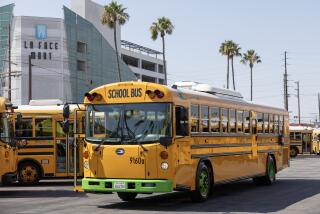Back to School
- Share via
Thousands of Southern California students go back to school this week, about 595,000 of them in the growing Los Angeles Unified School District alone. There are desks enough for all of them, though not necessarily at a school on the traditional September-to-June calendar or at the school closest to home. But a guarantee of enough desks to go around in coming years will require steady, decisive planning.
Enrollment is up statewide because of immigration, migration and a high birthrate. The Los Angeles system, the most severely overcrowded, expects up to 15,000 new students on Tuesday--the largest one-year increase in more than 20 years.
Because public school districts cannot turn away youngsters simply because there is no room, classroom space must be found for all comers--if not in a neighborhood school, then in a temporary bungalow or a school across town or on a campus of a community college.
New schools--modern, spacious and well-equipped--provide more permanent relief for overcrowding, but classroom buildings take years to fund, plan and construct. That process needs speeding up.
More money for school construction may soon be in the pipeline. Gov. George Deukmejian is expected to sign legislation to provide $5 billion over five years for school construction across the state. California’s voters should follow Sacramento’s lead and approve the $800-million construction bond issue on the Nov. 4 ballot.
The new money would help, but even those millions of dollars would not keep pace with growth that is expected to add 600,000 students by 1990. The Los Angeles district plans to build 19 new schools and expand 24 existing campuses within five years. That would make room for 22,000 students, but enrollment is expected to grow by 82,000 pupils.
School districts in Orange County also are growing fast. Two districts, Capistrano and Saddleback Valley, have imposed new fees on developers to pay for schools. Santa Ana is going to year-round schools--a necessity in many places.
Marking up a calendar can be done quickly and at a fraction of the cost of building a new school. At year-round schools, groups of students attend classes for 45, 60 or 90 days, then go on vacation for 15 to 42 days. The starting dates are staggered, as are the abbreviated vacations. The non-traditional calendar may disrupt family life and force students to study in mid-summer, sometimes in rooms without air conditioning, but it also allows more youngsters to use the same desk.
The Los Angeles school board chose not to increase the number of year-round schools this term. Currently, 130,000 students are expected to attend 93 year-round schools. The district will probably have no other choice next year. Other current solutions include busing 39,000 students away from overcrowded schools and assigning 1,300 high schoolers to secondary classes held on seven community college campuses.
Back to school will mean many things to the millions of youngsters returning to California’s public schools this September. They all deserve a decent place in which to learn.
More to Read
Sign up for Essential California
The most important California stories and recommendations in your inbox every morning.
You may occasionally receive promotional content from the Los Angeles Times.













